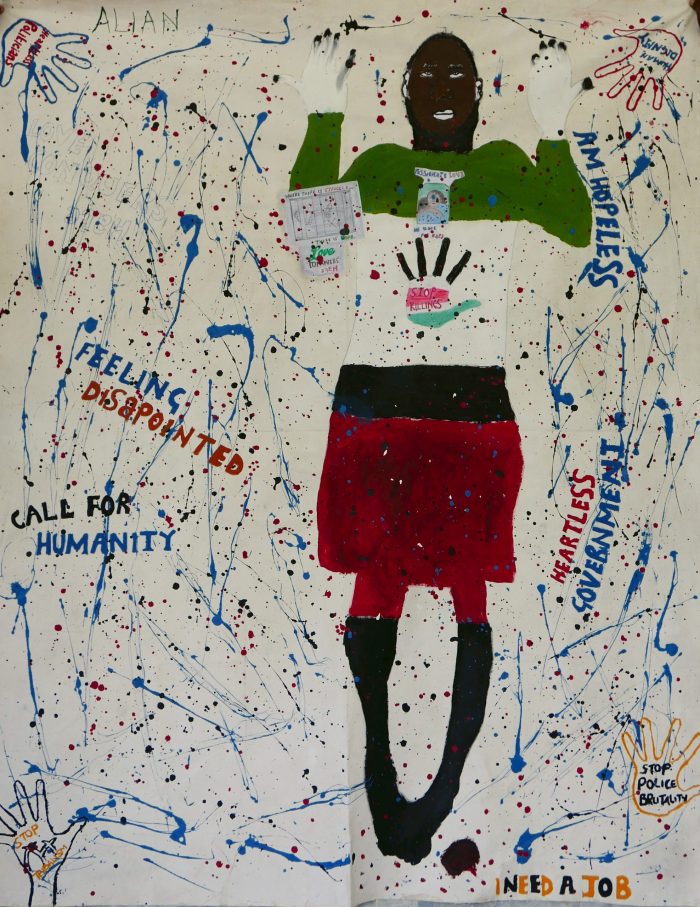Alian
Hopeless Kenyans
Everyone has a story: you find first what is inside you, what you do or do not do, and later you reflect on the outside world. Once you know these two things, you are able to engage, face people and conquer the outside world. I have never seen people do such things. This workshop has been unique.
The title of my painting is “Hopeless Kenyans” and it talks most about how the government is treating the community. My message is that the youths in this country have never been engaged in anything and that is why they are very bitter. Politicians are eating well, driving nice cars and shopping in big malls. But we, as common citizens, do not have the authority or ability to do that. Except for a birth certificate and an ID card, the Kenyan government never gives you anything. We are paying taxes for nothing. I just live to get cash today, eat and wait for tomorrow. I do not know what the next day will be like. The government and the politicians are the ones making this community bitter and driving it into violent extremism. They only come to the community when they want our votes. The Kenyan political system should be changed. There should be citizen participation. People should know their rights and should know how they can exercise them.
The colours I chose for my painting are red, black, green and white as a symbol of Kenya, the same colours as the Kenyan flag. I chose blue to symbolise people’s feelings of bitterness and used black to show that people lack choices and opportunities.
I chose to paint the hands in this praying position. This is like I am asking for help from God. I drew the feet together, as if fixed or tied. This is to show feelings of helplessness. You feel that you do not have any rights; you cannot do or say anything, and you are blocked. There is no freedom and no escape. You cannot go anywhere. You are just praying to God. That is how Kenya is now. There is a feeling of hopelessness and disappointment. This is about joblessness.
This is a window but it is also like a cage. This represents the feeling at the community level with no jobs and nowhere to go. No one wants to listen to them, so they feel like they are caged, kept in a place where they can’t get out. These arrows are representing the struggles people go through in Kenya – like trying to get jobs, live a good life – but there’s no way you can live a good life. These are madafu or coconuts. They represent hope. I am trying to say that, “wherever there’s struggle, there is hope”. So, the hope is here to fight corruption, tribalism and the like.
I have written “no place for hate” and I drew a woman inside my heart. The woman there is my mum. My mum is a good loving person. She does not speak that much and keeps to herself. My dad made her that way. He is the kind of person who, when mum wants to go out, she has to ask for permission. If he says no, it is a nay. She was treated like a slave. She has no voice. That strong mother-son bond was not there. I always think about her and I want her to know that I am there for her. That is why I drew her.
I also wrote “love conquers hate”. This is about my wife-to-be Rashida. She really understood me, encouraged me, and gave me hope. She played a big role in my life. She was so close to me. She took a role my mum would have had. A mother is someone who should talk to her children to show them the right path. Rashida talked to me as a mother and a friend. So, love conquers hate. We need to love each other so that we can get to help each other and have a good life, but hatred will never help. Hate is built in so many things. We have to remove hate from ourselves to be able to receive and feel love.

